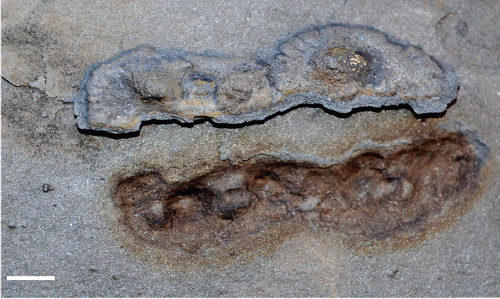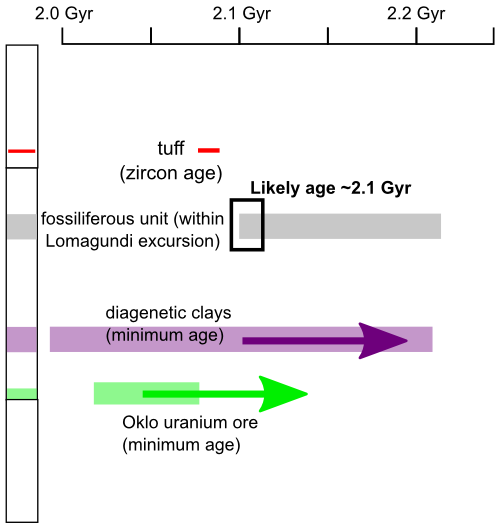![]()
![]() The fossil record prior to 550 million years ago is so patchy that every discovery is going to cause some fanfare. That is certainly case with these odd looking things, which have been proclaimed in Nature as the oldest mulitcellular organisms ever found.
The fossil record prior to 550 million years ago is so patchy that every discovery is going to cause some fanfare. That is certainly case with these odd looking things, which have been proclaimed in Nature as the oldest mulitcellular organisms ever found.

A 2.1 billion year old fossil atop the bed it was preserved in. Source: Albani et al., Fig. 2
These flat, dish-like fossils are found at a number of horizons within a black shale unit of the Francevillian Group in southeast Gabon. They grew in a marine delta environment, and following a rapid burial event, sulphate-reducing bacteria got to work decomposing them. One by-product of sulphate reduction is pyrite, and as a result decomposition left a durable, mineralised impression of what was consumed.
To my admittedly inexpert eyes, these things do not immediately scream ‘multicellular!’ at me (in contrast to, say, the enigmatic Stirling fauna) – they look like some kind of bacterial mat. However, Albani et al. have used high resolution X-ray scans to reveal a complex internal structure, and what they argue is evidence of coordinated growth patterns, both of which suggest a higher degree of organisation than a bacterial colony [Update: Go and read Ed Yong’s write-up for a number of semi-sceptical expert opinions].
The age of the Francevillian Group is given as 2.1 billion years (2100 million), and it is this great age that makes these fossils so potentially significant: if they are multicellular, then they are the oldest known large multicelluar organisms by a margin of about 200 million years (it’s not clear in the article, but I think that the Stirling fauna is what has been usurped). It seems not everyone is so impressed by this*, but it does push the possible origins of multicellularity back much closer to the oxygenation of the Earth’s atmosphere between 2400 and 2300 million years ago, which must have had a significant evolutionary impact on life. If this discovery pans out, a hypothesised connection between the two becomes slightly less tenuous.
Because precisely dating such old rocks is a tricky business, I was curious to know exactly how good the age constraints on the Francevillian Group were. As it turns out, they are actually pretty good. By a lucky happenstance, the unit just above the fossil-bearing layers has a zircon-bearing tuff which has been extremely precisely dated as forming 2080 million years ago. This provides a minimum age for the units below – they had to have already been there when the tuff erupted. Another minimum age comes from the Oklo uranium ore deposit, which is found at a slightly lower stratigraphic level, is pretty famous in its own right, and is known to have formed around 2050 million years ago. Because the ore body is the result of later mineral growth some time after deposition of the host rock, the host rock must be older than the ore. Diagenetic clays just below the fossil-bearing layers, which probably formed shortly after deposition, have also been less accurately dated at around 2100 million years ago.
A final chronological clue is provided by the observation that carbonate minerals within the fossil-bearing sequence have elevated levels of carbon-13 with respect to carbon-12. A similar trend (known as the Lomagundi excursion after the place in Zimbabwe it was first identified) has been found in sequences between 2220 and 2100 million years old from Africa, South America, North America, Scandanavia and Australia. Correlating to what seems to have been a global change in seawater chemistry therefore provides maximum and minimum estimates for when the fossil organisms lived and died. When combined with the other age constraints described above, particularly the age of the overlying tuff, an age towards the younger end of this interval seems to be the most reasonable interpretation, hence the 2100 million year estimate given by the authors.

So, whilst the significance of these Gabonese fossils can be debated, they are almost certainly around 2.1 billion years old.
*only people used to working in the Archean and Proterozoic can be blasé about such lengths of time. 200 million years from the present day, dinosaurs were still at the beginning of their reign, and all the continents were collected together into Pangaea, so it’s not an insignificant interval in terms of evolution or geology. Although to be fair to Daniel, he’s mainly responding to a media write-up that propagates the whole ‘nothing biologically interesting before the Cambrian – except THIS!’ trope.
Albani, A., Bengtson, S., Canfield, D., Bekker, A., Macchiarelli, R., Mazurier, A., Hammarlund, E., Boulvais, P., Dupuy, J., Fontaine, C., F?ºrsich, F., Gauthier-Lafaye, F., Janvier, P., Javaux, E., Ossa, F., Pierson-Wickmann, A., Riboulleau, A., Sardini, P., Vachard, D., Whitehouse, M., & Meunier, A. (2010). Large colonial organisms with coordinated growth in oxygenated environments 2.1‚ÄâGyr ago Nature, 466 (7302), 100-104 DOI: 10.1038/nature09166



Comments (11)